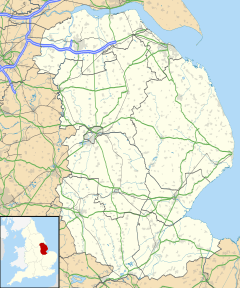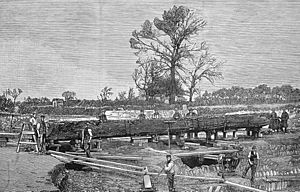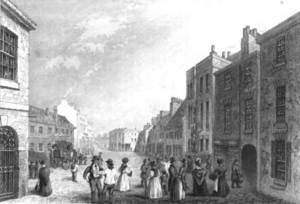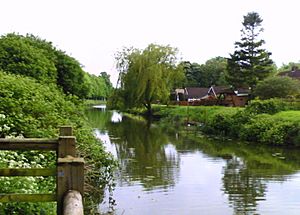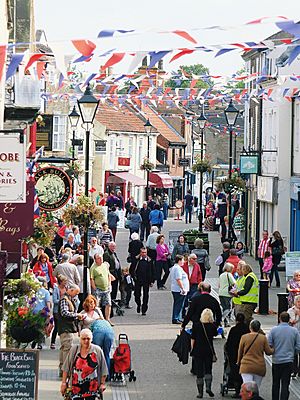Brigg facts for kids
Quick facts for kids Brigg |
|
|---|---|
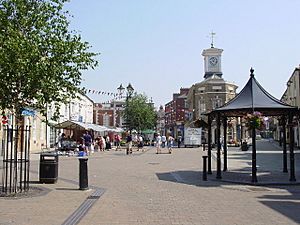 Brigg Market Place |
|
| Population | 5,626 (2011 census) |
| OS grid reference | TA003073 |
| • London | 140 mi (230 km) S |
| Unitary authority | |
| Ceremonial county | |
| Region | |
| Country | England |
| Sovereign state | United Kingdom |
| Post town | BRIGG |
| Postcode district | DN20 |
| Dialling code | 01652 |
| Police | Humberside |
| Fire | Humberside |
| Ambulance | East Midlands |
| EU Parliament | Yorkshire and the Humber |
| UK Parliament |
|
Brigg is a lively market town in North Lincolnshire, England. It's home to about 5,600 people, based on the 2011 census. The town is located where the River Ancholme meets important travel routes across northern Lincolnshire. Brigg's full name, Glanford Brigg, is even used for the area and local government district around it. The nearby village of Scawby Brook is also part of Brigg's town area.
Contents
Brigg: A Town with a Rich History
Early Days
The area where Brigg now stands has been used for thousands of years. People crossed the Ancholme River here and used the river itself for travel. Very old boats, made from sewn pieces or hollowed-out logs, have been found in the town. These boats are about 2,900 years old! There was also a causeway or jetty by the river during the late Bronze Age. We don't know exactly what it was used for.
During the time of the Anglo-Saxons, this area was called Glanford. The meaning of "Glanford" isn't fully clear. It might mean "ford where fun sports are held" or "a smooth ford." Another idea is that it refers to a special walkway made of logs over muddy ground.
Medieval Times
Glanford Brigg was officially founded at the river crossing before 1183. The town received its first official permission for a weekly market and a yearly fair in 1205. This permission was given by the king to Hugh Nevil. The fair started on July 25th, which is Saint James's Day, and lasted for three days.
The second part of the town's name, "Brigg," comes from the new bridge built to replace the old river crossing. The word "Brigg" comes from an old Norse word, bryggja, which usually means a jetty or quay, but here it means a bridge.
Brigg was originally located where four different parishes met. These were Broughton, Kettleby, Scawby, and Wrawby. Most of the town was in Wrawby parish. In the 1190s, a hospital for the poor was built in Brigg. There were also small chapels. However, when monasteries were closed down in the 1500s, Brigg was left without its own church services. People had to go to the parish church in nearby Wrawby.
Later History
During the English Civil War, Brigg was a strong point for the Royalist army. But after a battle in 1643, the Parliamentarian forces attacked and took over Brigg.
In 1669, a local landowner named Sir John Nelthorpe left money in his will to start and support a free school in Brigg. This school still exists today! In 1699, a new chapel was built, bringing church services back to the town after 150 years.
Brigg was greatly improved and rebuilt in the late 1700s and early 1800s. The old town hall, now called the Buttercross, was built in 1817. Later, in 1842–43, the chapel was replaced by a full-sized church called St John the Evangelist. Brigg finally got its own church parish in 1872, separating it from Wrawby.
A workhouse was built in Brigg in 1835 to help people who were very poor. It later had a hospital attached, which stayed open until 1991.
How Brigg is Governed
Brigg is part of the unitary authority of North Lincolnshire. Most of the town is in the Brigg and Wolds area, represented by three local councillors. Brigg also has its own town council with nineteen members.
Historically, Brigg was part of Lincolnshire. It is still part of the ceremonial county of Lincolnshire today. Local government in Brigg started in 1864. In 1974, Brigg became part of a new area called Glanford borough, named after the town. When Glanford was dissolved in 1996, Brigg became part of North Lincolnshire.
Brigg is part of the Brigg and Immingham area for national Parliament. It is represented by Martin Vickers from the Conservative Party.
Where is Brigg?
| Weather chart for Brigg | |||||||||||||||||||||||||||||||||||||||||||||||
|---|---|---|---|---|---|---|---|---|---|---|---|---|---|---|---|---|---|---|---|---|---|---|---|---|---|---|---|---|---|---|---|---|---|---|---|---|---|---|---|---|---|---|---|---|---|---|---|
| J | F | M | A | M | J | J | A | S | O | N | D | ||||||||||||||||||||||||||||||||||||
|
48
6
1
|
38
6
1
|
48
9
2
|
48
11
4
|
51
15
7
|
53
18
10
|
53
20
11
|
64
20
11
|
48
18
10
|
48
14
7
|
56
9
3
|
53
7
1
|
||||||||||||||||||||||||||||||||||||
| temperatures in °C precipitation totals in mm source: Intellicast |
|||||||||||||||||||||||||||||||||||||||||||||||
|
Imperial conversion
|
|||||||||||||||||||||||||||||||||||||||||||||||
Brigg is about 230 kilometers (140 miles) north of London. Nearby big towns include Lincoln (35 km or 22 miles south), Scunthorpe (11 km or 7 miles west), Grimsby (27 km or 17 miles east), and Hull (23.5 km or 14.6 miles north).
The town sits on a gravel area that sticks out into the valley of the Ancholme River. This spot was a good place to cross the river. To the east, the Lincolnshire Wolds hills rise to about 100 meters (330 feet). To the west, the land gently slopes up to about 70 meters (230 feet).
The Ancholme River flows north through a flat, low-lying area. This area used to be a marshy wetland. But from the 1630s to the 1820s, drainage projects turned the valley into farmland. The biggest drainage channel is also a canal called the New River Ancholme. The original river is now called the Old River Ancholme.
Brigg is mostly on the east bank of the Old River. A small part is on the west bank. Because it's so close to the river, Brigg sometimes has small floods. There are also several clay ponds in Brigg where clay was dug out for making bricks.
Town Layout
The old part of Brigg is around the marketplace and nearby streets like Bridge Street and Wrawby Street. The marketplace and Wrawby Street are now for pedestrians only. Many buildings in the town center are from the late 1700s or early 1800s and are considered historic. The old town is a "Conservation Area."
The marketplace features the Buttercross and the Angel, which used to be a coaching inn. The Angel now houses the Brigg Town Council. Another old inn, the Exchange, is on Bigby Street. The Anglican church of Saint John the Evangelist, built in 1843, is also on Bigby Street.
In the past, many poorer homes were in narrow alleys north of the marketplace. These areas were considered unhealthy in the late 1800s. The houses were finally removed in the 1950s. However, the alleys themselves are still used today. Some larger ones are now shops or services, and smaller ones are public walkways.
The A18 cuts through the town, just north of the center. New houses built in the 1900s have expanded the town significantly to the north and east. To the west, Brigg's urban area extends into Scawby Brook. The town is surrounded by the M180 motorway to the north and a railway line to the south.
Brigg's Economy
Brigg's economy mainly focuses on retail and services. It acts as a service center for the villages around it. Wrawby Street is the main shopping street. Many businesses are independent, keeping the traditional feel of a high street. However, some larger chain stores like Tesco and Lidl also have stores in town.
A general market is held on Thursdays and Saturdays. A farmers' market takes place on the fourth Saturday of each month. Here you can find local produce like pork, organic vegetables, and even ostrich meat! You can also buy local cheeses and artisan breads.
Light industry is located on the Island Carr and Atherton Way industrial estates. A large gas-fired power station is to the southwest of the town. Another power station, which burns straw, has been approved to be built next to it. Many people who live in Brigg travel to work in nearby Scunthorpe and Grimsby.
In the past, Brigg's industries were more connected to farming. There was a sugar beet factory, a livestock market, and Spring's jam factory. The town also had a corn exchange where local corn prices were set. The Falcon Cycles bicycle factory was in Brigg for many years.
Fun Things to Do in Brigg
Brigg has many local events and activities. There are three main yearly fairs: the Summer Fest in June, the Horse Fair in August, and a Christmas Fair in November. Other events include the North Lincolnshire Music and Drama Festival in March and a beer festival in May. The Briggstock Acoustic Music Festival happens in early September. Brigg Live Arts also holds a cultural festival and art exhibition every two years.
Public facilities in Brigg include two health centers, a library, a heritage center, and three children's playgrounds. There is also a Tourist Information Centre in the marketplace.
Sports and Activities
Brigg is home to Brigg Town Football Club, known as the Zebras because of their black and white striped uniforms. The team has won the FA Vase twice, in 1996 and 2003.
The Ancholme Rowing Club, started in 1868, is located in Manley Gardens. It holds a big race every October, attracting teams from across England.
Lincsquad organizes two triathlons and a quadrathlon in and around the town each year.
The Ancholme Leisure Centre is on Scawby Road. It has swimming pools, a sports hall, a gym, and a skatepark. The Recreation Ground on Wrawby Road offers space for field sports.
The Brigg Horse Fair
The town hosts a yearly horse fair on the first Saturday of August. Many Romani and Irish Travellers come from all over England to attend. The fair is a chance to buy and sell horses, but it's also a big social event for the community.
Some people say it's the second largest horse fair in England, after the Appleby Horse Fair. It's also a very old tradition, continuing the medieval fair that started in 1205. This means the fair is over 800 years old! The fair is also the subject of a famous folk song called Brigg Fair.
Brigg's Music Connection
Brigg is famous for being the place where several early English folk songs were recorded. In 1905–06, a composer named Percy Grainger heard local singers perform songs like Brigg Fair and Lisbon. These songs inspired Grainger's own work, Lincolnshire Posy, and later Frederick Delius's Brigg Fair.
Local News and Radio
Local news and TV shows for Brigg are provided by BBC Yorkshire and Lincolnshire and ITV Yorkshire.
Local radio stations include BBC Radio Humberside (95.9 FM), Hits Radio East Yorkshire & North Lincolnshire (96.9 FM), and Greatest Hits Radio Lincolnshire (97.6 FM). Steel FM is a community online radio station from nearby Scunthorpe.
The local newspaper that serves the town is the Grimsby Telegraph.
Getting Around Brigg
Most travel to and from Brigg is by road. The A18 goes through the town, connecting it to the national road network. The M180 bypasses the town for longer journeys. A few bus services operate in the town, mostly going to Scunthorpe. On Thursdays, a bus service travels only within the town for the weekly market.
Brigg railway station is on the railway line that goes from Sheffield to Lincoln. There is only one train per day in each direction on weekdays for passengers. However, the line is still used often for moving goods.
Humberside International Airport, near Kirmington, is about 8 kilometers (5 miles) away.
The Ancholme River was once used a lot for transport. Now, it's mostly used for fun activities like boating.
Learning in Brigg
Primary schools in Brigg include Brigg County Primary School and St Mary's Catholic Primary Voluntary Academy.
For secondary education, Brigg has two comprehensive schools: The Vale Academy and the Sir John Nelthorpe School. These schools also work together to provide further education for students over 16. Students from Sir John Nelthorpe School call themselves Briggensians.
Famous People from Brigg
- Thomas Ball, who was a member of the New Zealand Parliament, was born in Brigg in 1809. He worked as a pharmacist in Brigg before moving to New Zealand in 1859 with 137 other local people.
- Gervase Elwes, a famous singer, had a family home in Brigg. He and his wife started the North Lincolnshire Music and Drama Festival in 1900. They hosted Percy Grainger, who collected folk songs there.
- Mat Dickie, an independent video game developer, was born and grew up in Brigg.
- Joan Plowright, a famous actress and wife of Laurence Olivier, was born in Brigg in 1929. Her brother David, a TV executive, was born a year later. The Plowright Theatre in nearby Scunthorpe is named after her.
- Matthew Sparrow, a footballer, grew up in Brigg and played football for Sir John Nelthorpe school.
- David Yelland, a journalist and former editor of The Sun newspaper, was a student at Sir John Nelthorpe School.
|
See also
 In Spanish: Brigg para niños
In Spanish: Brigg para niños


